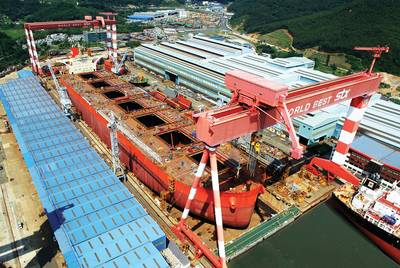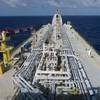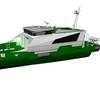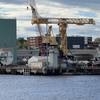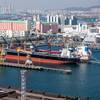The Year in Review
The last 12 months has been one for the books ... or the trash.
There was no shortage of government inducements to turn the lackluster tide in 2012—stimulus spending in China and Japan, quantitative easing by the U.S. Federal Reserve, and multiple actions by the European Central Bank to strengthen the Eurozone. But as the year evolved, weak macroeconomic fundamentals decisively trumped monetary policy initiatives and continued their choke on global commerce, hence the maritime sector. Anyone who characterizes 2012 as even marginally better for shipping than 2011 can do so only because the bar was set far too low. Both last year and the current one will go down in maritime business annals as part of a bleak, monotonous, and particularly long period of volatility that began in 2009. This was yet another excruciating year for the global maritime community.
The Big Picture
Initial estimates from the International Monetary Fund show a 3.2% growth in the 2012 world gross domestic product, one of the slowest in recent years. Remarkably, even the Chinese and the Indian economies cooled and did not reach their anticipated targets. Rampant wage inflation is holding back the Chinese manufacturing prowess, and their containerized exports to the United States dropped for the second year in a row. India too is experiencing its slowest rate of economic growth in a decade. Russia’s entry into the World Trade Organization in September 2012 did not have any perceptible effect on global commerce, unlike the Chinese entry a decade ago that unleashed an unprecedented shipping boom in 2003.
Overall, worldwide sluggish economic growth, along with prolonged excess capacity and escalating operating costs, worsened the market stagnation. The much-awaited resurgence in global commerce and maritime trade is still on hold, and instability continues to plague major trade regions and shipping routes.
The 2013 PricewaterhouseCoopers’ annual Global Shipping Benchmarking Survey provides revealing insights on the sector’s plight. It reports 1% average return on net operating assets for the shipping industry in 2011, well below the 18% that existed in 2007, when the shipping boom was at its peak. For the dry-bulk sector in particular, the return was 35% in 2007. Shipping companies included in this survey posted a negative 2 percent average return on equity in 2011, versus 21% in 2007. The ratios for 2012 are currently not available, but are estimated to be worse.
Not surprisingly, a recent Moore Stephens report rated one out of every ten British shipping companies as a “zombie,” a colorful addition to the shipping finance vernacular. These are companies with a low asset base, barely covering their variable costs and close to bankruptcy. Trade journals report that the value of publicly traded shipping companies has declined on average 75%, in some cases up to 90%. The general feeling among investment gurus is that few public shipping companies today have any equity, let alone goodwill value. The current risk exposure of banks engaged in shipping finance is $475 billion, according to an estimate from the shipping consultancy Petrofin. This explains the recent Lloyd’s List finding that barely 15 banks are actively engaged in new shipping-finance initiatives.
Drewry Shipping Consultants believe the unprecedented 2004–2008 shipping-business peaks are unlikely to be repeated. We may indeed be back to the “old normal” cycles, with the last couple of years being extraordinarily humbling.
Market Developments
All major shipping markets experienced tough conditions in 2012, which ended somewhat similarly to 2011. But at least there is wider acknowledgment that—barring unpredictable happenstance—we have indeed reached the nadir; there is nowhere to go but up. The liquefied natural gas (LNG) market was one odd exception in 2012; it registered strong performance. Worldwide shipping capacity utilization dropped yet another notch, to 84%, per recent R. S. Platou statistics. This is the second lowest it has ever been during the past decade. Increased labor and fuel costs and new environmental regulations are escalating operating costs, while the freight revenue is declining or at best remaining stagnant.
On the positive side has been a sharp decline in orders for building new ships, even though the cost of construction today is the lowest it has been in a decade. This is not because the owners have suddenly become more rational in their investment decisions. On the contrary, most are experiencing a tough cash-flow situation, with bank loans hard to get. Furthermore, shipping asset values are still declining, although the rate stabilized somewhat in 2012. Thirty-nine percent of companies reported lowering the value of their ships, including two out of every three container shipping companies.
The recent Moore Stephens Shipping Confidence Survey registers a slight uptick, indicating signs of optimism in the market. Other promising developments include improving Chinese domestic consumption and anticipated good economic recovery by leading non-OECD (Organization for Economic Cooperation and Development) nations in 2013. The U.S. export of shale gas is another major positive change, though this may run afoul of domestic politics and seriously impact those making huge investments in LNG transportation.
Dry Bulk Market
The Baltic Dry Bulk Index (BDI), a barometer of that type of carrier’s earnings, averaged 920 points in 2012. This is the second lowest it has ever been, the worst being 715 in 1986, shortly after the introduction of BDI in 1985. The main reason for this is ship owners’ indiscretion and persistent overbuilding during the past four years. For example, Clarkson Research Services statistics show a 36 percent increase in the number of bulk carriers from 2009, despite worsening market conditions. In 2012 alone, while tonnage demand increased 7%, the fleet expanded 12%. The large bulk carriers (referred to as Capesize) that earned an average $116,049 per day in 2007 during the peak years averaged a meager $7,680 per day in 2012. The RS Platou–weighted dry-bulk index for 2012 dropped to $9,400 per day, from $15,200 in 2011. The figure here shows the decline in average daily freight rate for each of the four categories of dry-bulk carriers. Ship owners attempted to control the excess capacity by slowing the speed of their vessels and recycling older tonnage. This led to the removal of 529 bulk carriers, 37% of the total 1,414 ships recycled in 2012.
Vale, the Brazilian mining giant, has also inadvertently contributed to the extremis situation faced by Capesize bulk carriers. Its strategy revolves around using 32 very large ore carriers (VLOCs) of around 400,000 deadweight tons (DWT) to better control their supply chain and lower the total logistics cost. Twenty-four of these giant ships are now in operation, and 8 more are on order. A Lloyd’s List analysis shows that the volumes shipped on Vale’s own fleet went up as planned, from 30 percent in 2011 to 46.1% in the last quarter of 2012. However, contrary to Vale’s expectations, the supply-chain costs including maritime freight costs escalated. There is widespread belief that the VLOCs are inefficient and costly, in addition to having various operational challenges. Nevertheless, these massive ships have directly impacted the demand for Capesize bulk carriers and worsened the excess-capacity situation.
Tanker Market
This turned out to be the most complicated shipping market in 2012 for a number of reasons. Major developments included a wide embargo on Iranian oil and the near-total return of Libyan oil, as well as the stunning bankruptcy of tanker giant Overseas Shipholding Group (OSG), a venerable name in American shipping. AP Moller-Maersk, another tanker giant, with 116 owned and 46 chartered ships, posted a net deficit of $314 million for the year, surpassing its $153 million loss incurred in 2011. The value of modern very large crude carriers continued its downward slide. The older tankers are now worth only their value in scrap iron.
The first half of the year provided good trading conditions for crude carriers, whereas the second half favored product carriers. Because the big Asian importers substituted Iranian oil with West African crude, while the United States replaced West African crude with Saudi Arabian exports, both the crude-oil and refined-product sectors benefited from increased sailing distances. Sixty-seven percent of the 1.1 billion tons of crude oil exported from the Middle East, the world’s largest exporting region, went to the Indian subcontinent, Southeast Asia, and the Far East.
India in particular has also attracted sizable crude traffic from the Caribbean to source its 1-million-barrel-per-day super refinery in Jamnagar, from where the products are distributed globally. The combined effect of a small increase in total oil traded, greater sailing distances, and lower fleet productivity through slow steaming (with the average speed dropping to 12 knots from 12.5, per RS Platou statistics) was not enough to boost the market returns in this sector. The medium-size crude tankers in particular became victims of the change in the U.S. oil-sourcing pattern.
The current tanker fleet is exceptionally young, at an average age of eight years. Relative to its size, new orders placed in 2012 were the lowest ever. Among notable new-building orders was the recent decision by BP (British Petroleum) to build 13 new “green” tankers. Another was the Frontline plan to spend $2.6 billion on 53 new fuel-efficient tankers.
This will help it emerge as the world’s largest eco-ship fleet and hopefully, the most profitable as well, taking advantage of the current low cost of new ship construction.
The global fleet of small-product tankers (27,000-42,000 deadweight capacity, often referred to as handysize tankers) is shrinking, whereas the medium-range tonnage is growing rapidly.
This reflects the changing dynamics in oil trade caused by India’s and China’s building of huge refineries, while several older refineries shut down in the Atlantic basin and Europe.
Shipbuilding Market
The prolonged uninspiring market conditions have had a perceptible impact on the shipbuilding sector. Furthermore, with all new shipbuilding orders, there is an emphasis on fuel efficiency and energy sustainability.
The South Korean lead in this field is now limited to tankers and LNG ships, while the Chinese have surged ahead in other sectors, including containerships.
Chinese yards received 40 %of all new orders in 2012, followed by South Korea with 38% and Japan with 15%.
However, it is far from smooth sailing for the Chinese. The massive 13-fold expansion in their shipbuilding capacity from 2002 to 2011, discussed in reviews of previous years, has now become a liability, and the country cannot meet the planned $80 billion annual export value of ships constructed. Three large state-owned shipping companies placed a $4.5 billion order for 50 supertankers to be built in China in 2012, a timely gesture of solidarity with their struggling yards. This is also an important strategic move, as the nation will have greater control over its energy supply chain—critical for continued economic growth.
The tight market conditions again led to significant slippage in the delivery of new tonnage, and this is expected to continue. Furthermore, a number of dry-bulk and tanker new-construction orders were canceled despite unavoidable financial penalties. New-construction prices have been dropping throughout the year, not only because of surplus shipbuilding capacity and stringent bank financing conditions, but also a major drop in the price of steel. It is estimated that the cost of building new ships today is 40% below what it was in 2008; as evidence, the Clarksons’ new-building price index dropped to 73 at the end of 2012, from 95 in 2011 and 124 in 2007. The 2013 RS Platou Report estimates the worldwide decline in steel price alone has brought down the cost of constructing a Korean-built Aframax tanker by $8 million. Global shipbuilding capacity has shrunk one-third from its 2008 peak through yard closures and cutbacks.
Cruise Market
On January 13, 2012, the Costa Concordia ran aground and capsized after the ill-advised decision by Captain Francesco Shettino to cruise too close to the shoreline of Giglio, an island off Italy. Thirty-two drowned, in tragic and avoidable stories and with legal repercussions that are covered here later. Despite that negative beginning for the cruise sector, 2012 turned out to be another banner year, attracting 5.4% more passengers worldwide than in 2011.
According to Cruise Lines International Association (CLIA) statistics, the total fleet today consists of 336 ships of 1,000 gross tons or more, with an annual passenger-carrying capacity of more than 17 million. Two of every three who boarded a CLIA-owned cruise ship in 2012 were from the United States or Canada, with Australia the fastest-growing market. The average fares dropped in 2012, reflecting the prevailing market conditions.
There are 24 cruise ships (valued at $15.8 billion) for delivery between now and 2017. All but six of are of the megaship type (2,000-plus berths), the biggest being the $1.32 billion Oasis-class ship for Royal Caribbean International, due for delivery in 2016. Another anticipated delivery that same year is a nostalgic replica of RMS Titanic.
Dr. Shashi Kumar is a Master Mariner, Fulbright Senior Specialist Fellow and Professor Emeritus of International Business and Logistics. He is in his 26th year of distinguished leadership and educational services to the U.S. and global maritime community.
The views expressed in this article are the author’s own and not those of the U.S. Merchant Marine Academy, the Maritime Administration, the Department of Transportation or the United States government.
Excerpt which was Reprinted from U.S. Naval Institute Proceedings with permission; Copyright © (2013) U.S. Naval Institute/www.usni.org.
(As published in the June 2013 edition of Maritime Reporter & Engineering News - www.marinelink.com)



